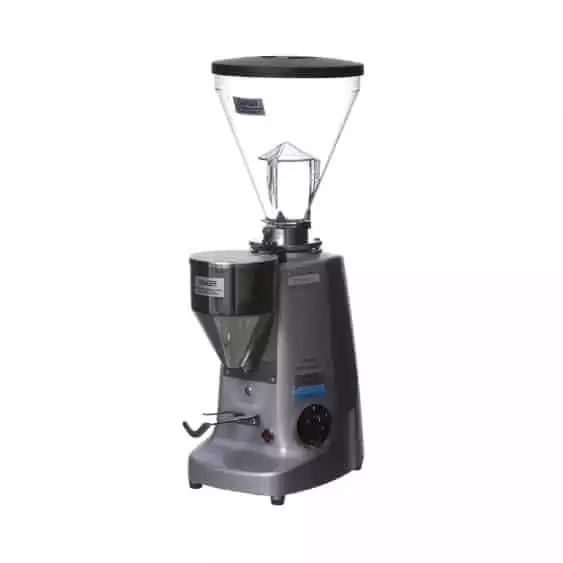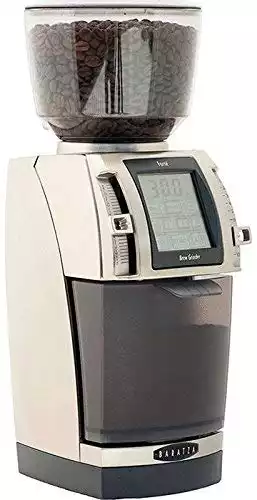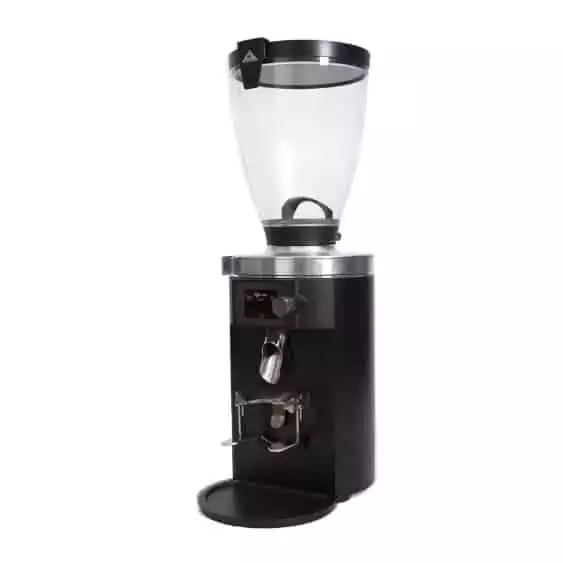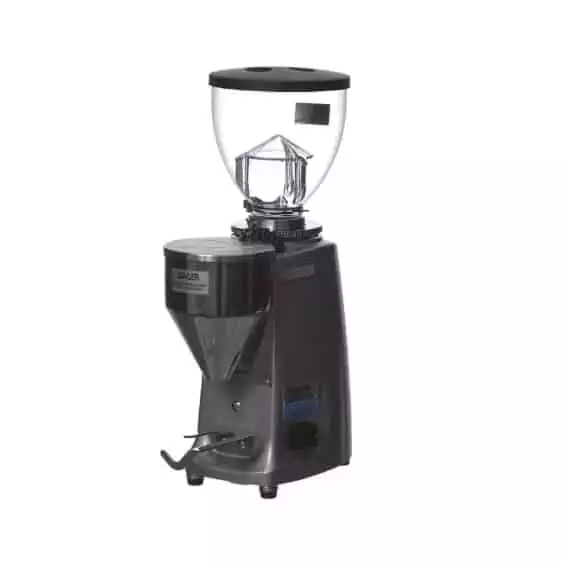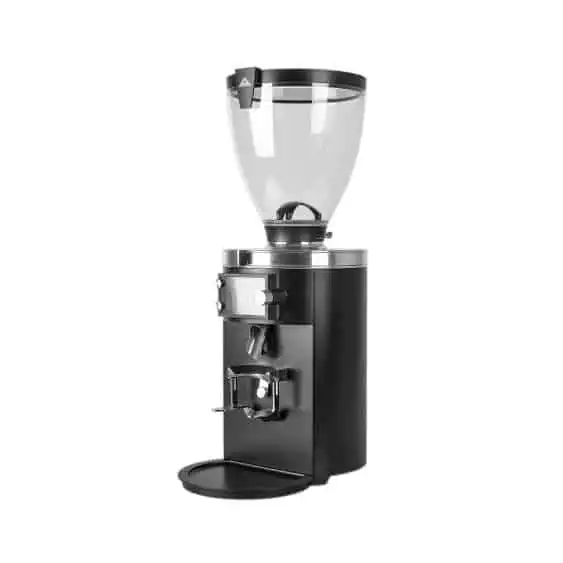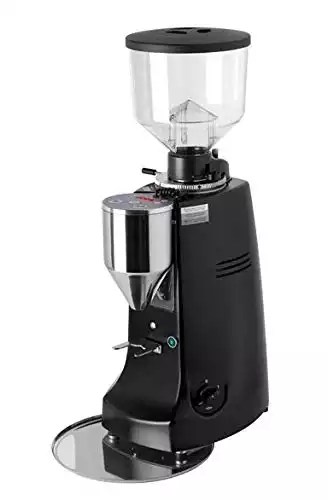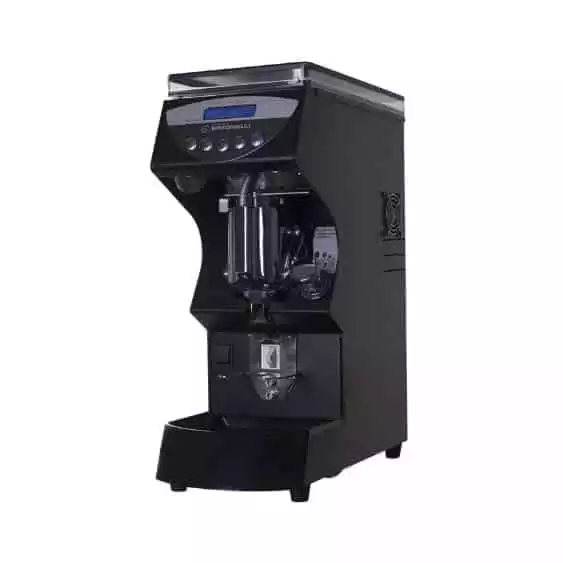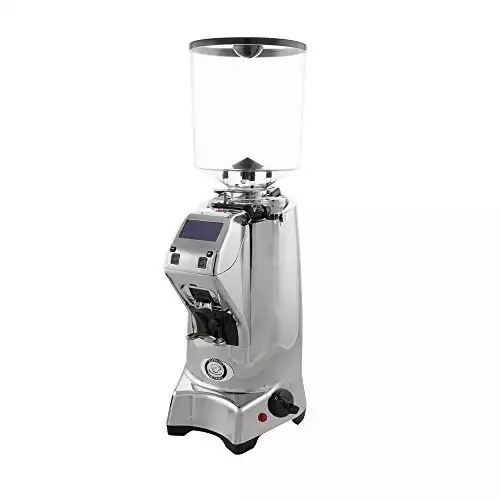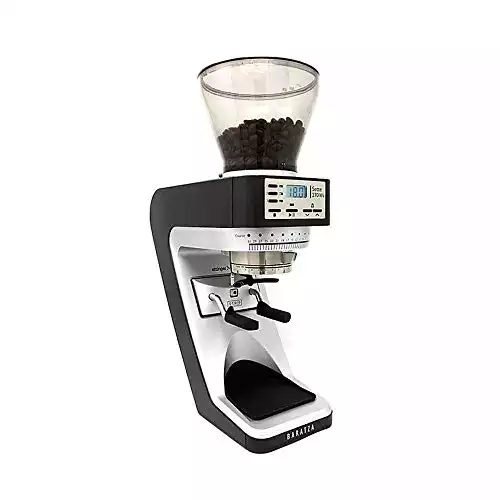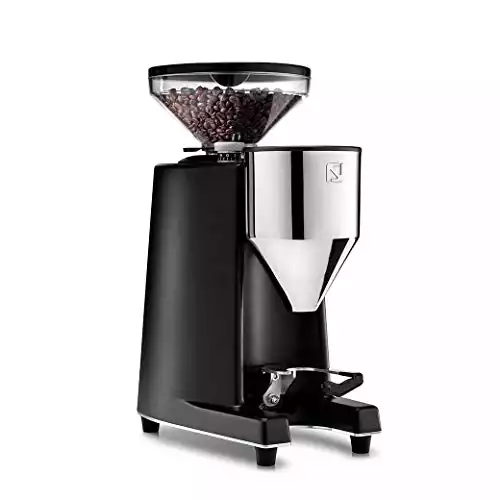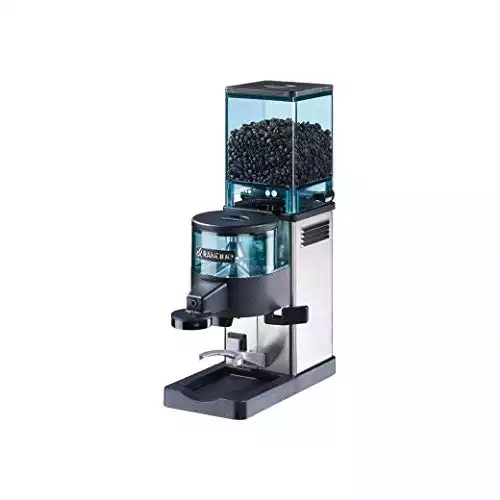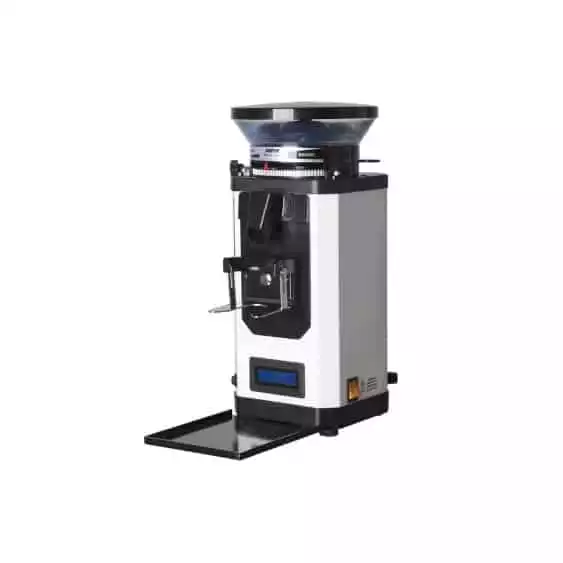Best Commercial Coffee Grinder 2024
Exceptional coffee that impresses your customers requires exceptional coffee grinders.
As an experienced coffee trainer, I can attest to the fact that the grinders you use have a huge impact on the results for customers and drink workflow.
Yup. You may even spend thousands of dollars on grinders for your business, and If you want to up your coffee game with the best commercial coffee grinder available, keep reading.
This guide to the best commercial coffee grinders will help you discover what your business needs and which will be the best coffee grinder for your unique situation.
But, if you’re in a hurry, here are the top picks:
Commercial Coffee Grinders – Buying Considerations
What should you consider when looking at commercial coffee and espresso grinders?
There are dozens of options, and making the right choice can be confusing.
The first step in choosing coffee grinders doesn’t involve looking at all the options or even the price tags. First, you want to consider the needs of your business.
Your Business
If you’re unsure which coffee grinders to get, you might be tempted to go for the biggest one or the most expensive model.
On the other hand, if you’re on a tight budget, you might be inclined to choose the cheapest option.
Alas, none of these points should guide you.
Your first step is to think of your business and what you need now, along with what you will need in the case of future growth or expansion.
Let’s go through the main aspects of your business that impact the type of coffee grinder you will need.
I’ll help you review how the volume of coffee drinks you can expect in a day affects the type of equipment you need.
We’ll also discuss the type of coffee drinks you serve and what you need for consistency, reliability, budget, and burr type.
How Much Coffee Grinding Do You Need To Do?
How much coffee do your baristas serve up every day?
If your café is high volume, but your grinder can’t keep up, you’ll have frustrating delays as your grinder breaks down.
On the other hand, if you have a low volume of customers but buy a top-of-the-line grinder, you would waste precious resources on a piece of equipment that isn’t necessary.
For a small capacity coffee shop that serves about 20-50 drinks a day with a one-group espresso machine, you can go with a small option like the Mazzer Mini.
Smaller grinders are slower, but it’s not an issue if you’re only doing a couple of dozen drinks in a day.
In a coffee shop that’s doing several hundred drinks a day, though, a few seconds of lag time is a huge factor.
In that case, you want to invest in a bigger, faster machine that will take just a few seconds to grind each dose.
You don’t want to make grinding coffee a challenging job in a busy cafe.
Also, the bigger faster machines don’t heat up as much even when working hard, which will keep the drinks tasting their best.
For higher volume settings, you might want to check out the Mazzer Super Jolly, which can grind fast all day long and is great for up to 200 drinks a day.
If you pump out more than 300 drinks a day, you’ll need a faster setup with a larger burr set, like the Mahlkonig E80 with its 80 ml burr set.
On a side note, think about the equipment size that fits in your work area. Experienced baristas know that if the workspace is small, a large machine that takes up unnecessary and vital workspace that your baristas needs isn’t practical. There’s no need to have huge capacity grinders if the workspace is limited.
Along with overall volume, consider peak hours.
Although we do tend to talk about how many drinks per day, we should focus on how those drinks are spread out throughout the day.
Many coffee shops and restaurants have peak hours where the number of customers surges. You want to adjust between low volume and high-volume hours without losing quality.
What is your busiest hour of the day? How many drinks do you have to get out during that time frame?
If you’re doing not 200 drinks a day but 200 drinks in a one-hour time frame, you need a machine that can pull its weight and get those drinks out fast, with little heat buildup and adequate consistency.
This leads me to my next point, which is often a problem for many coffee shops:
Consistency
Since flavor is undoubtedly important to you and your customers, keep an eye on grind consistency when choosing burr grinders.
Experienced baristas know that consistent grind size helps to repeat the same drinks repeatedly with the same results.
When checking out consistency, note how the best commercial coffee grinders do with particle size distribution.
That refers to how many large and small particles are in the same ground coffee dose. This variation directly affects consistency and quality.
Larger particles under-extract, while smaller particles over-extract. That could give you either sour or bitter coffee. And if you combine both smaller particles and larger ones in one dose, the flavor of the coffee will be muddled.
In espresso, when your dose has both larger and smaller particles, water moves through the coffee in an irregular path, which creates channels and results in poorly extracted shots.
In your search for consistent and accurate grinds, you’ll need to choose between stepless grinders or stepped grinders.
Stepped grinders have notches built in so that you don’t have to guess where to set the grind. Stepless grinders don’t have those notches.
Stepless grinders might be difficult for newer or less experienced baristas to handle. Figuring out the perfect grind size when they go between an espresso grind and a grind for drip coffee with a stepless grinder might take some time.
For more experienced baristas or in situations where you won’t switch up grind sizes, stepless grinders allow them to dial in the grind they need more accurately.
Great for when you need to brew coffee rapidly and serve different drinks.
When discussing accuracy, dosing accuracy is vital. Grinders should dose the same amount of coffee every time, or at least get close. When testing burr grinders, weigh several doses to evaluate how they do with consistency.
Budget
Obviously, the price will come into play when deciding which one to purchase. You might be tempted to go with the cheapest one, but don’t let price be your only guiding factor.
A cheaper machine that breaks down often or that has to be replaced frequently is not the best buy for most cafes or restaurants.
But a high-end machine might not be the best option if you have a low coffee volume. There’s no need to invest in expensive coffee grinders if the use doesn’t warrant it.
Burr type
When you look at the technical specifications of burr grinders, you’ll come across the burr type. There are two main choices: flat burr grinders and conical burrs.
The difference between the two burr grinders is that flat burr grinders crush and cut the coffee beans.
Conical burrs include a cone-shaped area for the whole beans to go to, and the coffee beans are ground from all sides at the same time.
That makes conical burrs faster, up to twice as fast as flat burr grinders. And conical burrs excel at producing consistent coffee grounds.
Because of the size and the price point, conical burrs are generally best for high-end coffee establishments. As such, you’ll mostly see flat burr grinders assisting in producing espresso shots.
Espresso Drinks Or Pour Over & Cold Brew?
If you are only grinding for espresso drinks, you only need a commercial espresso grinder.
As the name suggests, the best commercial espresso grinders are capable of producing the finely ground coffee needed for espresso drinks.
But if you often grind coffee beans for pour-overs or immersion methods, you need a commercial coffee grinder that can easily grind coarse or fine. A French Press or Cold Brew, for instance, needs coarse ground coffee.
Going back and forth between that fine and coarse grind can be difficult to dial in fast. A way out is to have two burr grinders, an espresso grinder, and another one for pour-overs.
But at times, the cost of purchasing and maintaining two grinders doesn’t make sense for small coffee shops or restaurants.
Additional considerations
Doser Grinders
How does the grinder dose the coffee?
There are two main types: doser grinders and doserless grinders.
Doser grinders deposit the ground coffee in a recipient, and from there the barista can manually dose out each shot. This can be a good option for cafes with a large volume of customers, since the coffee can be ground in larger amounts and then dosed out manually. But coffee that isn’t freshly ground can suffer in terms of quality.
Doserless grinders put the ground coffee dose right into the portafilter. With doserless grinders there’s no holding chamber, so the coffee may be fresher. Baristas learn to work quickly getting the shots out, and there’s less waste.
Additionally, dosing can be done either by timer or by weight. Grinding and dosing coffee grounds with a timer is as basic as it sounds.
You’ve set a timer, and the machine will stop grinding when the time is up. You won’t know exactly how many grams are in that grind without going through the extra step of weighing the results.
On the other hand, when you have a grind by weight grinder, it will stop grinding when it reaches the weight you programmed in.
So you can just set the coffee weight and let the machine do its thing. It’s far more accurate.
Depending on your setup, a grind by weight feature can also mean faster customer service. This is because baristas don’t need to take time to weigh each dose before brewing.
Noise & The Grinding Process
Noise level is also important in your coffee shop. Do your customers expect a Zen-like quiet?
They won’t be pleased with a loud grinding sound breaking their concentration. Are your customers looking for a lively, noisy café? How loud your equipment is might not be a consideration for you.
A word about clumping. Flat burr grinders produce static electricity as they spin at high speed, which causes the coffee grounds to clump up.
Clumps create uneven grind distribution in the portafilter. As the water is forced through the coffee grounds, it takes the path of least resistance, which causes channeling. And that creates both under and over-extraction, which means the flavors in the espresso shots will be off.
Some grinders get around this clumping problem by having what they call a declumper or clump crusher. This is especially important in finer grinds, like those used for espresso.
Reliability
Reliability, when you brew coffee, is a big factor. Before you buy grinders, check out how reliable it is.
What’s the reputation of the brand? How often will you have to service the grinder? How serious will the repairs be?
If your commercial grinder breaks down frequently, you’ll have serious workflow problems as your baristas figure out a way to keep making coffee.
Many shops have a spare commercial grinder for emergencies. Also, before buying check to make sure that parts and service are available in your part of the country (or world).
The Quality Standard
What quality do your customers expect?
If they want the freshest, most complex specialty coffees, you’ll have to be extremely careful with accuracy, consistency, and freshness.
For customers who are more interested in a fast cup rather than in quality, you can focus more on fast machines than other considerations.
Let’s get into the best commercial grinders for your business.
The 12 Best Commercial Coffee Grinders 2024
1. Mazzer Super Jolly Electronic Doserless Espresso Grinder
PROS (+)
- Attractive all-metal design
- Durable
- Grind size adjusts from very fine to very coarse
CONS (-)
- Large size takes up considerable workspace
- Clumping can be an issue
A respected company in commercial espresso grinders, the Mazzer Super Jolly will keep up with medium volume while providing a high-quality grind for larger cafes or restaurants.
If your café serves everything from espresso to immersion coffees, the Mazzer Super Jolly gives you complete control over grind size.
This durable, popular espresso grinder adjusts well from super fine to very coarse.
An attractive design with an all-metal build makes this doserless grinder more durable. The 64 mm flat burr grinder is fast and keeps heat buildup to a minimum.
This stepless grinder does well for an entry-level up to a mid-volume shop that does hundreds of cups of coffee a day.
It has electronic dose adjustment, but you can adjust it manually for single and double doses.
A stepless grinder, you can make minute adjustments to the grind size. Dosing can be adjusted from 5.5 to 9.0 g, and you can choose from single shot, double shot, or on-demand dosing.
The digital display also shows you the shot counter, and the hopper holds a generous 2.7 pounds.
Having a hands-free grinder can help with workflow. After all, less time that your baristas focus on the machines, more time they can interact with customers.
On the downside, adjusting the whole collar to change the grind setting can be tricky.
Clumping can be an issue, and the large size (9.5 inches wide and 16.5 inches deep) might take up too much valuable workspace in small shops. It’s also a bit slower than some comparable burr grinders.
2. Baratza Forte BG Brew Grinder
PROS (+)
- Good price point
- Durable
- Accurate
CONS (-)
- Small volume
- Slow
The entry-level pricing of the Baratza Forte BG makes it popular with smaller cafes or restaurants that do a modest volume.
It excels in medium to coarse grinds but does not go fine enough for espresso. However, Its capacity and low price point make it an ideal second grinder for pour overs and immersion methods.
What else makes the Baratza Forte a good choice?
The all-metal construction, 54 mm flat steel burrs, and the reputation of being a workhorse keep this grinder on the list.
The small size also helps. At just 5.5 inches wide and 5 inches deep, this square grinder is tiny and great for small cafes or bakeries.
The tiny size, though, doesn’t mean it can’t provide accuracy. On the contrary, it has a dizzying 230 programmable grind settings, both weight-based and time-based dosing, and a large capacity hopper for this size grinder.
It’s also easy to service. Of course, this won’t be the grinder for your business if you need a fast machine that can keep up with a busy cafe. But it might just be what you need in a backup grinder.
3. Mahlkonig E80
PROS (+)
- Fast
- Powerful
- Good temperature management
CONS (-)
- Takes up a lot of space
- Comes with a high price tag
The Mahlkonig E80 has a minimalist, stylish design and looks strong. It means business, and it lives up to appearances.
With 80 mm flat burrs, this grinder is fast. In fact, it’s often considered the fastest grinder on the market.
The powerful motor ensures a grind time of 6-7 grams per second and is good for high volume day after day.
But don’t worry about the grinds heating up. This grinder has two cooling fans, and you can see the temperature on the main menu of the display home screen.
Dosing and grind are incredibly accurate with this grinder, with little variation between doses.
Unique burr geometry and the ability to adjust the distance between the burrs result in precision consistency. Quiet grinding doesn’t add to the noise level in your restaurant or coffee shop.
Disk distance detection on the display so you can see the actual distance between the burrs and the goal, makes it easy to calibrate between machines at different coffee shops or restaurants.
The attractive large bean hopper capacity is 1.8 kilos. The bag clip on the hopper lets you attach a card so customers can easily identify the coffee in the hopper.
Its display is high resolution and has a wide viewing angle. The fork is adjustable for a variety of portafilters or other methods.
The drawback to this grinder?
It comes with a high price tag that doesn’t fit into the budget of just any coffee shop. And at 63 cm high, this takes up valuable workspace. An ideal grinder for high-volume shops, this giant would overwhelm smaller businesses.
4. Mazzer Mini E Doserless Coffee Grinder
PROS (+)
- Small size good for cafes with limited workspace
- Good espresso grinder
- Stepless grind adjustment
CONS (-)
- Slower than larger grinders
- Doesn’t do coarse grinds
Looking for an espresso grinder that won’t clutter your workspace? As the name suggests, the Mazzer Mini E Doserless is ideal for small coffee setups.
With a 64 mm flat burr set up, the smaller burr size means it takes longer to grind each shot, about a gram per second.
Those few seconds slower will slow down the whole workflow, but that’s not a problem for smaller shops that aren’t under the same time crunch as larger setups.
The grinding adjustment is stepless and also micrometrical to allow you greater flexibility in grind settings. Use the electronic dose adjustment or manually add to your dose.
Small but attractive, this grinder comes in black matte or silver (which is polished aluminum). The digital display has an electronic keypad and electronic time dosing, as well as a shot counter.
The grinder is doserless and has a doser cone that guides the grinds right down into your portafilter. The 1.3-pound bean hopper is short, and even shorter ones are available. The shut-off valve makes it easy to switch between coffee beans.
The grind is very consistent and fine, making it an ideal espresso grinder. This isn’t the grinder for you if you need coarse settings or to go between grinding extremes.
A good commercial espresso grinder or for home baristas, the Mini fits in small spaces and can handle low-volume situations. This might be your second grinder for special coffee, such as your decaf offering or single-origin coffees.
5. Mahlkonig E65S GbW Espresso Grinder
PROS (+)
- Fast and precise
- Quiet grinder
- Easy to service
CONS (-)
- Not suitable for high volume
- Higher price point
The Mahlkonig E65S GbW is ideal for a low to mid volume café. Precise grinds and accurate dosing are backed up by a gorgeous digital display.
It takes about 3 to 4 seconds for the 65 mm flat steel burrs of this quiet grinder to produce a single dose, making it a fast machine. The internal cooling fan helps it keep its cool.
You can adjust recipes by weight or time and choose from three-dose settings to keep a good workflow while maintaining precision.
The manual stepless grinder adjustment helps you find the ideal grind settings. Also, the display shows the distance between the burr sets up to 1 micron, a reliable way to determine grind size and maintain it across several coffee shops or restaurants.
The portafilter detection mode records the weight of portafilters and assigns it a dose. So when you put a portafilter on the fork, the grinder will recognize which portafilter you’re using and will allot the dose weight you’ve programmed.
You can use a particular portafilter with a specific recipe to increase beverage consistency.
The ultra-fast tare time is at less than 1 sec. The removable chute directs coffee into the portafilter or can be adjusted if you’re using another brewing method. And a declumper evens out the grounds.
This burr grinder is a more expensive investment, making it more suited for a shop with medium volume.
6. Mazzer Robur Espresso Grinder
PROS (+)
- Fast
- Durable
- Stepless adjustment
CONS (-)
- Dose consistency can be faulty
- High grind retention
The Mazzer Robur is a top-of-the-line grinder for high-volume businesses as the primary grinder. This powerful, huge, and fast machine can handle pulling doses all day long. The design is attractive and sleek enough for such a powerhouse.
Grinding at 6.5 grams per second, this grinder puts out a dose in under 3 seconds!
The 71 mm burr set grinder has stepless adjustment for grind settings and electronic timed dosing controls on the simple display.
Choose single or double dosing, and there’s a manual dosing button when necessary. It has a doserless funnel too for improved workflow.
On the downside, grind retention can be a problem, so purge the grinder of coffee often. And at 62 pounds, this grinder is not one that you’ll want to transport between shops often.
But this is a good overall grinder for high-volume cafes that don’t need to focus on consistency. This grinder is a high investment that ensures a high output.
7. Nuova Simonelli Mythos Commercial Espresso Grinder
PROS (+)
- Grinds fast
- Heavy duty
- Consistent
CONS (-)
- Large grinder takes up workspace
- Bulky, square design
The Nuova Simonelli Mythos One Clima Pro Grinder is good for a high-volume coffee shop. Equipped with 75 mm flat burrs, this machine is fast, precise, and consistent.
The stepless grind adjustment and smooth micrometric adjustment dial let you achieve precise grind settings. It’s easy to program doses with the electronic controls, and you can program up to 3 timed doses.
This grinder has low grind retention so there’s less waste and more precision. The cooling system keeps an ideal temperature throughout the day, even during peak hours, which improves shot performance.
The bulky, square design takes up countertop space with a footprint that’s almost 20 inches deep and 7.5 inches wide. The hopper holds 7 pounds.
8. Eureka Zenith 65 E Hi-Speed Espresso Grinder
PROS (+)
- Fast
- Accurate
- Stepless grind adjustment
CONS (-)
- Unattractive design
- Large footprint
The Eureka Zenith 65 E grinder has a 65 ml flat burr set that is faster than its competition. The dosing system is digitally timed, and stepless adjustment makes dialing in a breeze. The aluminum casing protects this durable espresso grinder, and the display is easy to read and use.
Count on consistent and accurate grinding with stepless grind adjustment and a micrometrical adjustment wheel. Cleaning is easy without changing the calibration.
You can adjust the portafilter angle and dispenser spout without a problem, and the portafilter holder is hands-free. The clump crusher eliminates clumps in coffee grounds for better shots.
You can choose the bean hopper size according to your needs. A one-pound bean hopper is good for low volume, while the three-pound bean hopper capacity is useful in higher volume situations.
My biggest gripe with this grinder is the industrial look, and it’s not the most attractive grinder on this list. It looks more like a 1970s domestic robot. It’s also quite tall at 23.5 inches, so make sure you have the space.
9. Baratza Sette 270Wi Conical Burr Grinder
PROS (+)
- Conical burr grinder
- Low grind retention
- Weight-based dosing
CONS (-)
- More adequate for office or home use
- Small size
An espresso-oriented conical burr grinder, the 40 mm steel conical burr set of the Baratza Sette 270Wi makes it more suited to very low volume commercial uses or home setups.
This Baratza makes it easy to dial in shots because it’s a stepless grinder that gives you seemingly endless microgrind possibilities.
You can count on consistent weight-based dosing that uses Acaia scale technology. Choose from three programmable presets.
The 40 mm steel conical burrs are designed to allow coffee fines to fall out into the portafilter directly, leaving almost no grind retention.
Low grind retention eliminates unnecessary waste. Although the specs boast faster grinding, a more realistic grind is up to 4 grams per second for espresso and 6 grams per second for drip coffee.
If you’ll be changing the grind size from espresso to drip or pour-over, you’ll like the adjustable forks.
You can use it with your portafilter, but with a simple twist you can adjust it to an open position to grind into a dripper or bin.
It allows for hands-free grinding with accurate aim into the portafilter. The bean hopper has a small 10-ounce capacity with a shut-off valve for easy switching between coffee beans.
Obviously, the small size and capacity make it a burr grinder for occasional use rather than as the main grinder.
The affordable price makes it a great choice for an office or as a second grinder for a coffee shop that needs to grind coffees that have a low-volume demand, such as decaf.
10. Nuova Simonelli G60
PROS (+)
- Good price point
- Easy to use
- Attractive design
CONS (-)
- Only grinds fine
- Clumping can be an issue
The Nuova Simonelli G60 has an attractive design that fits in any café setting or restaurant. It works well as a high-end household coffee grinder, for small shops or restaurants, or as a secondary commercial coffee grinder.
Consistent, fast, and user-friendly, this small stepless grinder with 60 mm hardened steel flat burrs programs easily with an attractive LCD display is consistent, fast, and user-friendly.
The stepless adjustment spans the range between espresso and drip, though it doesn’t go to the coarsest settings. Timed dosing lets you choose between single and double shots at 0.1-second adjustments or use the manual mode.
This coffee grinder has a funnel to guide the ground coffee down to the portafilter. The funnel is a big beak-looking object on the front of the grinder, but it does the job.
With a short, one-pound hopper, you can easily fit the coffee grinder under cabinets. The hopper has a shut-off lever to make it easy to change up the beans.
While these burr grinders have a good price point, they’re best as espresso grinders. You’re not going to get a very coarse grind, so it’s not adequate for French Press and barely gets it fine enough for pour-overs. Also, you might have some slight problems with clumping.
11. Rancilio MD 40 Commercial Burr Espresso Grinder
PROS (+)
- Durable
- Good for small coffee shops
- Powerful motor
CONS (-)
- Semi-automatic
- Doser
The semi-automatic Rancilio MD 40 comes equipped with a modest-sized burr set that’s good for small coffee shops, at a good price range.
It’s a workhorse, constructed of aluminum covered in polished steel. The tempered steel burrs and powerful motor for its size give you a sturdy grinder that can be great for grinding coffee for small cafes or as a secondary coffee grinder.
This coffee grinder has a doser, which can be a plus if you want to grind for several coffees at once and then dose them out separately.
While that takes longer per coffee, for a small shop with low volume the extra seconds it takes to dose is not going to affect the overall workflow.
The one-pound hopper has UV protection too, which protects the coffee from sunlight that degrades the coffee beans faster.
12. Anfim Cody II Commercial Coffee Grinder
PROS (+)
- Affordable
- Small size fits in most workspaces
- Easy to transport
CONS (-)
- Boxy design
- Slower than some competitors
A well-known name in espresso equipment from Italy, the Anfim Cody II is an ideal entry-level coffee grinder at an accessible price range.
The 64 mm flat steel burr set provides adequate grinding for low volume use, and the features are user-friendly.
At a grind speed of 1-2 grams per second and 800 RPM, it’s fast enough for smaller setups.
Stepless grind adjustment with the knob, able to make fine adjustments. And easy to dial in. Uniform grind
The tiny mini hopper is small at a 1 pound capacity, which is convenient and practical for most smaller volume businesses. This rather stout, tiny coffee grinder stands at 17.3 inches and 14.2 inches deep.
It is rather square, but small enough for many countertops without stealing necessary space, and it can fit under some kitchen cabinets.
Doserless and with a sturdy portafilter hook. Single and double dosing settings that are completely adjustable for the time you want.
Also, a manual grind switch allows you to grind for the time you need. The portafilter holder is easy to adjust to changing needs.
These commercial espresso grinders are of excellent quality and great value for the price, similar to more expensive models. They’re powerful in spite of their size.
This is a good choice if you don’t have a high-volume shop, and it’s durable even if you have to transport it to events, such as pop-up coffee shops or farmer’s markets.
But in my opinion, the square, boxy design would look better in a laboratory rather than a fashionable coffee shop.
The Final Verdict
What are the best commercial espresso grinders for your business? Let’s look at that question from the perspective of the volume of customers in your cafe.
For a low-volume shop: Mazzer Mini. This espresso grinder fits in small spaces and can handle the low volume in small cafes or for a home setup. It also takes up less counter space.
For a mid-volume shop: Mazzer Super Jolly. The Mazzer Super Jolly will keep up with medium-volume traffic while providing a high-quality grind and uninterrupted workflow.
For a high-volume shop: Mahlkonig E80. Perhaps the fastest grinder on the market, the powerful motor of this Mahlkonig will keep up with the needs of a high-volume shop.
But why stop at just one coffee grinder?
To keep your shop working, you may want to get two commercial coffee grinders on this list. Having a spare is a wise move, even if it’s a simple one that’s below the general needs of your business but can keep the shop going in case of an emergency.
You also might want that extra one for low-volume coffee beans, such as decaf or specialty coffees. If you do have a need for a second coffee grinder, consider the Baratza Sette or Mazzer Mini.

